
The Isle of Portland is a tied island, 6 kilometres (4 mi) long by 2.7 kilometres (1.7 mi) wide, in the English Channel. Portland is 8 kilometres (5 mi) south of the resort of Weymouth, forming the southernmost point of the county of Dorset, England. A barrier beach called Chesil Beach joins it to the mainland. The A354 road passes down the Portland end of the beach and then over the Fleet Lagoon by bridge to the mainland. The population of Portland is 12,797.

Weymouth and Portland was a local government district and borough in Dorset, England. It consisted of the resort of Weymouth and the Isle of Portland, and includes the areas of Wyke Regis, Preston, Melcombe Regis, Upwey, Broadwey, Southill, Nottington, Westham, Radipole, Chiswell, Castletown, Fortuneswell, Weston, Southwell and Easton; the latter six being on the Isle of Portland.

Sandsfoot Castle, also known historically as Weymouth Castle, is an artillery fort constructed by Henry VIII near Weymouth, Dorset. It formed part of the King's Device programme to protect against invasion from France and the Holy Roman Empire, and defended the Weymouth Bay anchorage. The stone castle had an octagonal gun platform, linked to a residential blockhouse, and was completed by 1542 at a cost of £3,887. Earthwork defences were built around the landward side of the castle, probably in 1623. Sandsfoot saw service during the English Civil War, when it was held by Parliament and Royalists in turn during the conflict. It survived the interregnum but, following Charles II's restoration to the throne, the fortress was withdrawn from military use in 1665.

Wyke Regis is a village in south Dorset, England. The village is part of the south western suburbs of Weymouth, on the northern shore of Portland Harbour and the south-eastern end of Chesil Beach. Wyke is 15 kilometres (9 mi) south of the county town, Dorchester. The village has a population of around 5,500.

South Dorset is a constituency represented in the House of Commons of the UK Parliament since 2010 by Richard Drax, a Conservative. The constituency was created as a consequence of the Redistribution of Seats Act 1885, although the area covered has changed since then.
Weymouth and Melcombe Regis was a parliamentary borough in Dorset represented in the English House of Commons, later in that of Great Britain, and finally in the Parliament of the United Kingdom. It was formed by an Act of Parliament of 1570 which amalgamated the existing boroughs of Weymouth and Melcombe Regis. Until 1832, the combined borough continued to elect the four Members of Parliament (MPs) to which its constituent parts had previously been entitled; the Great Reform Act reduced its representation to two Members, and the constituency was abolished altogether in 1885, becoming part of the new South Dorset constituency.
The Portland Branch railway was a railway line located on the Isle of Portland in the English county of Dorset. The line operated from the late nineteenth century until closing to passengers in 1952 and goods in 1965. For a short line, it had a complex history, built in three separate sections and operated jointly by two rival railway companies. Its construction needed twelve years of blasting through solid rock and three extensions of Parliamentary time.
Edmund Selous was a British ornithologist and writer. He was the younger brother of big-game hunter Frederick Selous. Born in London, the son of a wealthy stockbroker, Selous was educated privately and matriculated at Pembroke College, Cambridge in September 1877. He left without a degree and was admitted to the Middle Temple just over a year later and was called to the bar in 1881. He practised as a barrister only briefly before retiring to pursue the study of natural history and literature.
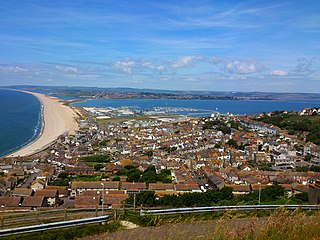
Weymouth is a seaside town in Dorset, on the English Channel coast of England. Situated on a sheltered bay at the mouth of the River Wey, 11 kilometres (7 mi) south of the county town of Dorchester, Weymouth had a population of 53,068 as of 2018. It is the third largest settlement in Dorset after Bournemouth and Poole.

The Rodwell Trail is a short-distance footpath that runs from Wyke Regis to the town centre of Weymouth in Dorset – a distance of 3.5 kilometres. The trail, opened in 2000, travels along the former route of the Weymouth and Portland Railway and is part of the South West Coast Path. The route follows part of the Jurassic Coast, and Sites of Special Scientific Interest. It is named after a neighbourhood of Weymouth which it passes through.

South West Coaches is a privately owned bus company that operates services around Dorset, Somerset, and Wiltshire, in South West England.
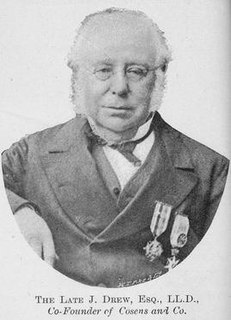
Joseph Drew was an English newspaper editor, steamboat proprietor, art collector, writer and lecturer.

AIR 107.2 is the community radio station for Weymouth and Portland. All content is broadcast from its studios in Weymouth via its transmitter located at Wyke Regis.

Castle Cove, also known as Sandsfoot Cove, is a small secluded sand beach to the west of Weymouth, in Dorset, southern England. It is in the parish of Wyke Regis, close to that village but closer to Sandsfoot Castle, one of Henry VIII's Device Forts, built around 1541 opposite its contemporary Portland Castle to protect Portland Roads. It is privately owned, but has remained open to the public and is a favourite spot for swimming, sailing, snorkelling and diving.
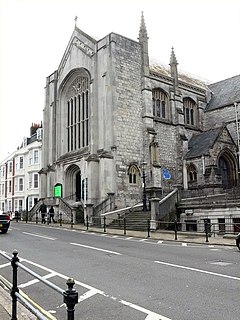
Holy Trinity Church is a Church of England church in Weymouth, Dorset, England. Built of Portland stone in 1834-36, and extended and re-oriented in 1886-87, the church is a Grade II* listed building. Designed by Philip Wyatt, it has been described as being of "intrinsic architectural interest", having an "unusual scheme of development" and "occupying a significant position on the axis of Weymouth's Town Bridge".

All Saints Church is a Church of England church of 15th-century origin in Wyke Regis, Weymouth, Dorset, England. Built largely of Portland stone, the Royal Commission on the Historical Monuments of England have described the church as a "remarkably consistent and unchanged 15th-century design". It has been a Grade I listed building since 1953. Facing Wyke Road from the modern cemetery opposite the church is the Wyke Regis War Memorial, erected in 1919.

St John's Church is a large evangelical Church of England church in Weymouth, Dorset, England. It was built in 1850–1854 to the designs of Talbot Bury and is a Grade II* listed building.
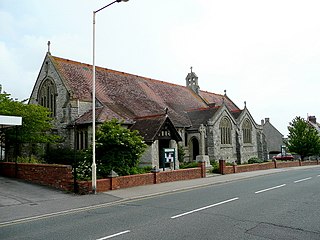
St Paul's Church is a Church of England parish church in Westham, Weymouth, Dorset, England. Designed by George Fellowes Prynne, the bulk of the church was built in 1894-96. It has been a Grade II listed building since 1974, with the World War I memorial outside also designated Grade II in 2016. In their book The Buildings of England: Dorset, John Newman and Nikolaus Pevsner noted the church's "idiosyncratic but convincing design".
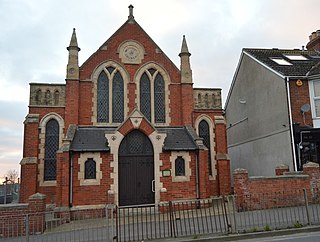
Wyke Regis Methodist Church is a Methodist church in Wyke Regis, Dorset, England. It was designed by Ford & Slater of Burslem and built in 1903. It remains active as part of the Dorset South & West Methodist Circuit.
















